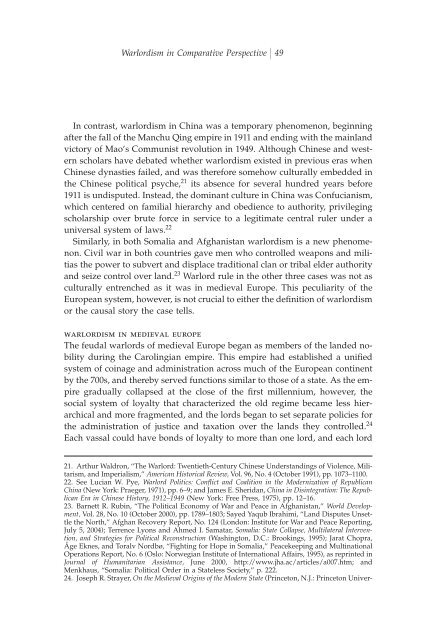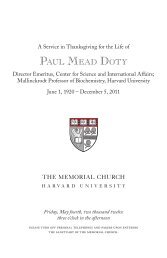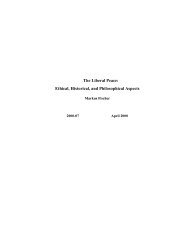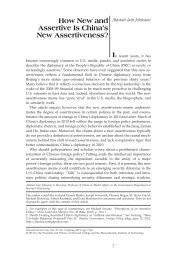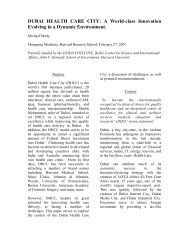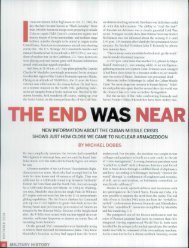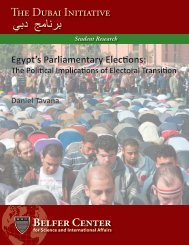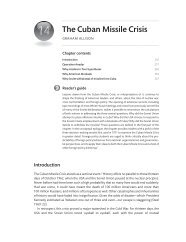Warlordism in Comparative Perspective - MIT Press Journals
Warlordism in Comparative Perspective - MIT Press Journals
Warlordism in Comparative Perspective - MIT Press Journals
You also want an ePaper? Increase the reach of your titles
YUMPU automatically turns print PDFs into web optimized ePapers that Google loves.
<strong>Warlordism</strong> <strong>in</strong> <strong>Comparative</strong> <strong>Perspective</strong> 49<br />
In contrast, warlordism <strong>in</strong> Ch<strong>in</strong>a was a temporary phenomenon, beg<strong>in</strong>n<strong>in</strong>g<br />
after the fall of the Manchu Q<strong>in</strong>g empire <strong>in</strong> 1911 and end<strong>in</strong>g with the ma<strong>in</strong>land<br />
victory of Mao’s Communist revolution <strong>in</strong> 1949. Although Ch<strong>in</strong>ese and western<br />
scholars have debated whether warlordism existed <strong>in</strong> previous eras when<br />
Ch<strong>in</strong>ese dynasties failed, and was therefore somehow culturally embedded <strong>in</strong><br />
the Ch<strong>in</strong>ese political psyche, 21 its absence for several hundred years before<br />
1911 is undisputed. Instead, the dom<strong>in</strong>ant culture <strong>in</strong> Ch<strong>in</strong>a was Confucianism,<br />
which centered on familial hierarchy and obedience to authority, privileg<strong>in</strong>g<br />
scholarship over brute force <strong>in</strong> service to a legitimate central ruler under a<br />
universal system of laws. 22<br />
Similarly, <strong>in</strong> both Somalia and Afghanistan warlordism is a new phenomenon.<br />
Civil war <strong>in</strong> both countries gave men who controlled weapons and militias<br />
the power to subvert and displace traditional clan or tribal elder authority<br />
and seize control over land. 23 Warlord rule <strong>in</strong> the other three cases was not as<br />
culturally entrenched as it was <strong>in</strong> medieval Europe. This peculiarity of the<br />
European system, however, is not crucial to either the deªnition of warlordism<br />
or the causal story the case tells.<br />
warlordism <strong>in</strong> medieval europe<br />
The feudal warlords of medieval Europe began as members of the landed nobility<br />
dur<strong>in</strong>g the Carol<strong>in</strong>gian empire. This empire had established a uniªed<br />
system of co<strong>in</strong>age and adm<strong>in</strong>istration across much of the European cont<strong>in</strong>ent<br />
by the 700s, and thereby served functions similar to those of a state. As the empire<br />
gradually collapsed at the close of the ªrst millennium, however, the<br />
social system of loyalty that characterized the old regime became less hierarchical<br />
and more fragmented, and the lords began to set separate policies for<br />
the adm<strong>in</strong>istration of justice and taxation over the lands they controlled. 24<br />
Each vassal could have bonds of loyalty to more than one lord, and each lord<br />
21. Arthur Waldron, “The Warlord: Twentieth-Century Ch<strong>in</strong>ese Understand<strong>in</strong>gs of Violence, Militarism,<br />
and Imperialism,” American Historical Review, Vol. 96, No. 4 (October 1991), pp. 1073–1100.<br />
22. See Lucian W. Pye, Warlord Politics: Conºict and Coalition <strong>in</strong> the Modernization of Republican<br />
Ch<strong>in</strong>a (New York: Praeger, 1971), pp. 6–9; and James E. Sheridan, Ch<strong>in</strong>a <strong>in</strong> Dis<strong>in</strong>tegration: The Republican<br />
Era <strong>in</strong> Ch<strong>in</strong>ese History, 1912–1949 (New York: Free <strong>Press</strong>, 1975), pp. 12–16.<br />
23. Barnett R. Rub<strong>in</strong>, “The Political Economy of War and Peace <strong>in</strong> Afghanistan,” World Development,<br />
Vol. 28, No. 10 (October 2000), pp. 1789–1803; Sayed Yaqub Ibrahimi, “Land Disputes Unsettle<br />
the North,” Afghan Recovery Report, No. 124 (London: Institute for War and Peace Report<strong>in</strong>g,<br />
July 5, 2004); Terrence Lyons and Ahmed I. Samatar, Somalia: State Collapse, Multilateral Intervention,<br />
and Strategies for Political Reconstruction (Wash<strong>in</strong>gton, D.C.: Brook<strong>in</strong>gs, 1995); Jarat Chopra,<br />
Åge Eknes, and Toralv Nordbø, “Fight<strong>in</strong>g for Hope <strong>in</strong> Somalia,” Peacekeep<strong>in</strong>g and Mult<strong>in</strong>ational<br />
Operations Report, No. 6 (Oslo: Norwegian Institute of International Affairs, 1995), as repr<strong>in</strong>ted <strong>in</strong><br />
Journal of Humanitarian Assistance, June 2000, http://www.jha.ac/articles/a007.htm; and<br />
Menkhaus, “Somalia: Political Order <strong>in</strong> a Stateless Society,” p. 222.<br />
24. Joseph R. Strayer, On the Medieval Orig<strong>in</strong>s of the Modern State (Pr<strong>in</strong>ceton, N.J.: Pr<strong>in</strong>ceton Univer-


